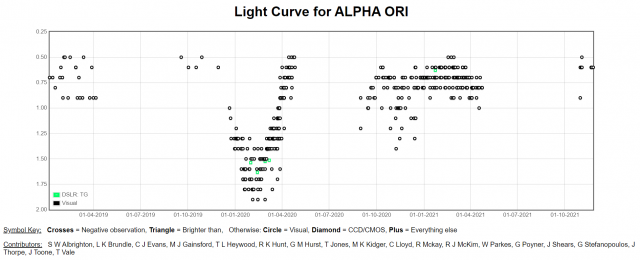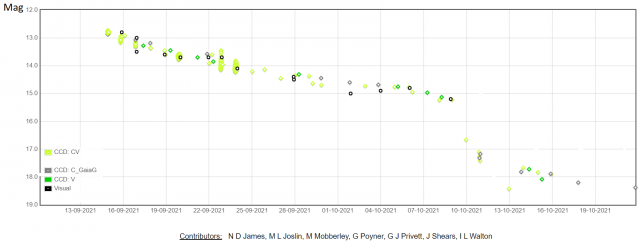Forum Replies Created
-
AuthorPosts
-
 Jeremy ShearsParticipant
Jeremy ShearsParticipantI can’t believe it’s 2 years since the great dimming of Betelgeuse. The latest light curve was shown in the recent Christmas Meeting Sky Notes by Nick James. There have been a couple of conferences dedicated to Betelgeuse in the last year. Here is a nice paper on “The curious case of Betelgeuse”, by Jacco van Loon (Keele U.) posted in ArXiv today.

 Jeremy ShearsParticipant
Jeremy ShearsParticipantFascinating reading that obit and bio. There must be so much more to tell, tho!
 Jeremy ShearsParticipant
Jeremy ShearsParticipantThis object is still around 13th mag and worth following:

 Jeremy ShearsParticipant
Jeremy ShearsParticipantI have the printed Journal for a few reasons.
1. I’m far more likely to read it. I have a mixture of other publications in either printed or electronic format. I am far more likely to read a printed edition. I tend to forget about a electronic publication. Or I might read a couple of articles, think I will continue another time, but don’t. It’s much easier for me to pickup and put down a printed edition, leaving it by my favourite chair.
2. I find it difficult to take in detail when I read it from a screen; I also absorb more info in printed format.
3. I much prefer the feel of a printed mag or book
4. Much of my day job is performed on screens. I look for opportunities not to use them when I can
The big advantage of electronic is when I travel. I can read the Journal anywhere on my iPad. But aways have that choice as my non-electronic sub also gives access to the electronic Journal
 Jeremy ShearsParticipant
Jeremy ShearsParticipantLooks like a busy December, Stewart!
 Jeremy ShearsParticipant
Jeremy ShearsParticipantWhat a fascinating project. Wouldn’t mind enrolling myself!
 Jeremy ShearsParticipant
Jeremy ShearsParticipantObservations made last night ~ Nov 29.9 by Tamas Tordai (Hungary) show beautiful ~ 0.1 mg humps, varying between ~12.4-12.5 in V (AAVSO data)
 Jeremy ShearsParticipant
Jeremy ShearsParticipantFurther info on this transient continues to roll in. Isogai et al. report that the spectrum of this object suggests it is a dwarf nova of the WZ Sge type. They also observed early superhump-like modulations that occur in this type of object. If confirmed this would be the WZ Sge-type dwarf nova having the largest outburst amplitude ever seen.
 Jeremy ShearsParticipant
Jeremy ShearsParticipant Jeremy ShearsParticipant
Jeremy ShearsParticipantAn ATel by Taguchi et al. (Tokyo U) reports a low res spectrum consistent with a nova, but a UGWZ dwarf nova classification cannot be ruled out at this stage.
More observations needed!
24 November 2021 at 5:14 pm in reply to: Suggestions for CV stars in the Southern Hemisphere #584932 Jeremy ShearsParticipant
Jeremy ShearsParticipantStewart, you can interrogate the VSX database
You can ask it to return UGSS, or UGER, or whatever you fancy. You can select to get the results returNed sorted by Dec, which will help you to find southerly targets
 Jeremy ShearsParticipant
Jeremy ShearsParticipantLink not working Maxim. I think it’s a transitory one – please can you post the reference
 Jeremy ShearsParticipant
Jeremy ShearsParticipantThis recent paper considers the origin of this flaring phenomenon – it’s actually about another nova, but they generalise to all of these slow, dusty systems. However, they state that it’s still an open question -and there may be multiple scenarios in different systems. They favour multiple episodes of mass ejection. They propose that the photosphere expands during a flare – the flares produce shocks which lead to high energy gamma-rays and dust production, others due to instabilities in the accretion disc around the white dwarf created by enhanced accretion stimulated by heating from the secondary star.
The authors of that paper (which include amateurs) make plea for further studies of other novae, so it is good that you and others are following this nova.
 Jeremy ShearsParticipant
Jeremy ShearsParticipantThis paper on ArXiv today on the light curve of the nova includes spectroscopy from BAA members: https://arxiv.org/abs/2111.02463
 Jeremy ShearsParticipant
Jeremy ShearsParticipantSuperb meeting. The BAA at its best. Many thanks to everyone involve!
 Jeremy ShearsParticipant
Jeremy ShearsParticipantNick – wanted to say that the presentation style is excellent – the way the speaker is shown, plus the slides. And the way the slide is expanded at times. Sound q very good too.
Whilst it would be great to be there in person, it’s actually a really good experience watching remotely too.
 Jeremy ShearsParticipant
Jeremy ShearsParticipantThanks Nick – working well
 Jeremy ShearsParticipant
Jeremy ShearsParticipantHere is the light curve of the superoutburst until today (observations from the VSS database). No rebrightenings have been seen.

 Jeremy ShearsParticipant
Jeremy ShearsParticipantAn ATel published yesterday reports that flickering in the light curve of RS Oph ceased during September: https://www.astronomerstelegram.org/?read=14974
This suggests that the recent nova eruption destroyed the accretion disc, as was found following the previous eruption. in that event,it reappeared after 240 days.
 Jeremy ShearsParticipant
Jeremy ShearsParticipantLL And has been in outburst for nearly a month, but it is now fading (Gary Poyner had at mag 16.7 last night, Oct 9.965).
However, some rarely outbursting dwarf novae sometimes exhibit rebrightenings (sometimes referred to as echo outbursts). These can occur a few days after the outburst is apparently over. And there can be more than one rebrightening.
Therefore please continue to observe this star. Nightly snapshot observations over the next week or two would be helpful.
-
AuthorPosts
